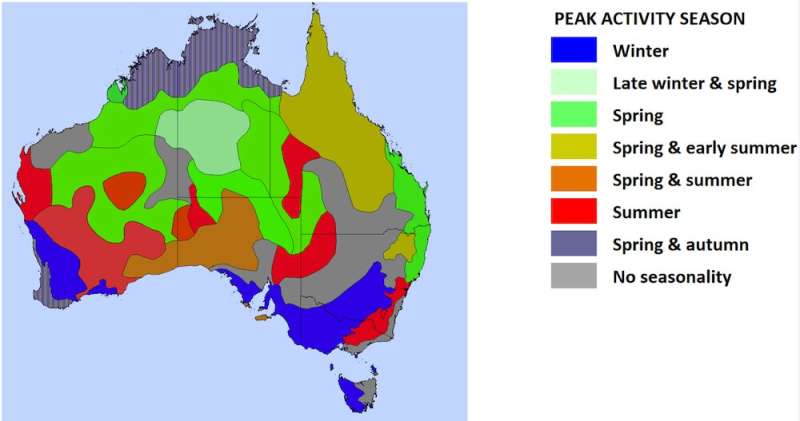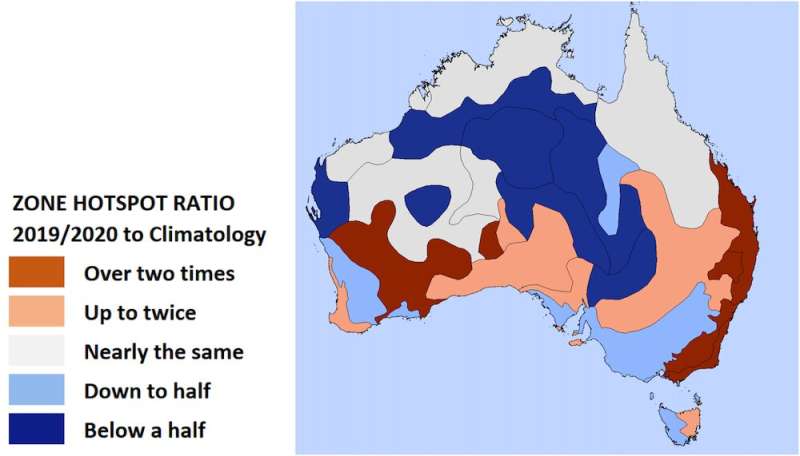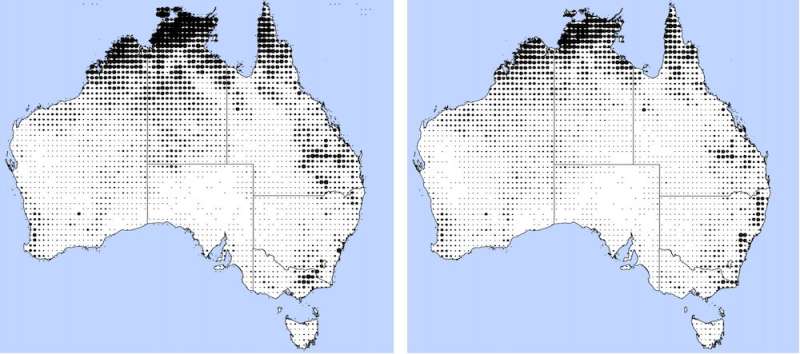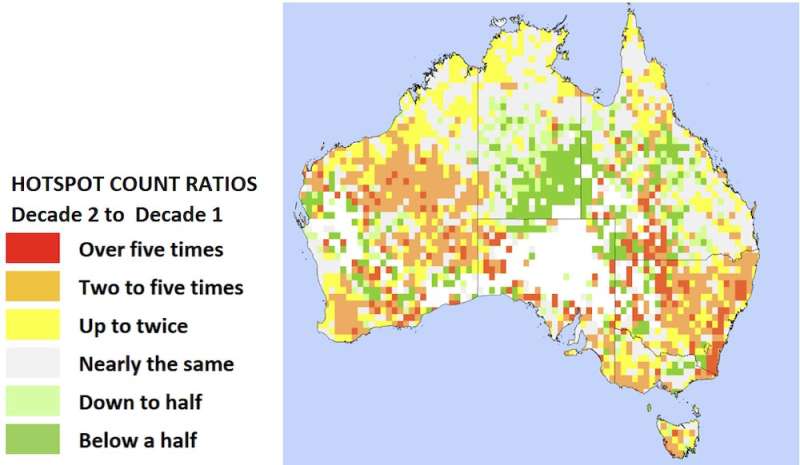This article has been reviewed according to Science X's editorial process and policies. Editors have highlighted the following attributes while ensuring the content's credibility:
fact-checked
trusted source
written by researcher(s)
proofread
In a bad fire year, Australia records more than 450,000 hotspots. Maps show where the risks have increased over 20 years

The bushfire outlook for many parts of Australia has changed drastically over the past decade. Environmental conditions have transformed, producing larger and more destructive bushfires.
The frequency of bushfires that alter the atmospheric conditions around them has also increased. Nowhere was this more evident than during the Black Summer bushfires of 2019–2020.
As we continue to experience the effects of climate change, these environmental changes and destructive fire events will only become more prevalent.
Thanks to satellite imaging data collected over the past 20 years, we can map and quantify the region-by-region impact of climate change and how this has affected the prevalence of fire in different parts of Australia. With more accurate bushfire modeling, we can assist fire services and land managers to determine where they need to refocus their efforts as we adjust to the long haul of adaptation to climate change.
To this end, the maps in this article show where fires occurred in two consecutive decades, and show the changes between them. They also show regions where those changes exceed a threshold, indicating a significant increase in fire activity. This enables better-targeted fire risk management.
Two decades of satellite fire monitoring
More than 20 years ago NASA launched two satellites, (Terra in 1999 and on Aqua in 2002), to monitor the Earth's surface with specialized sensors. One sensor, MODIS (MODerate resolution Imaging Spectroradiometer), was able to see both smoke plumes and the infrared signature of fires. An algorithm was developed to classify image pixels containing fire, producing a set of "hotspots".

Both satellites have lasted well beyond their planned mission durations. This is significant for fire managers, who now have two decades of continuous hotspot data.
Mapping Australia's fire hotspots
For many years I have been analyzing MODIS data from the perspective of seasonality. I have been looking at when fires occurred and whether that reflected expectations. The aim is to validate seasonal bushfire outlooks.
The past 20 years of annual seasonality reviews are now available online. Each year the previous 12 months' data were compared against those from a set time range or control period. This was a decade-long period covering a mix of El Niño and La Niña years, indicating "average" conditions.
Recently, we passed the end of the second decade of MODIS data. This opened the prospect of comparing two decades (starting in July 2002 and in July 2012) and looking for differences.
In a year with a lot of fire, Australia creates more than 450,000 hotspots. This makes the 20 years of MODIS data an irreplaceable tool for seamless, quantitative assessments of fire dynamics across Australia. The datasets are freely available online and have been used to create useful products to assist fire managers.
Several caveats apply to hotspot datasets. Low-intensity fires (especially well-planned, hazard-reduction burns), fires under heavy cloud cover, and fire runs that burn out quickly may not produce a hotspot. The latter was the case for many of the worst fire events during the Black Summer fires.

There is also no way to separate wildfire from planned fire. This has to be a goal, as both contribute to the fire regime but the balance varies a lot between regions. Future burn planning may become a major challenge as big wildfire events like Black Summer put much of the landscape into a single fire age. This makes burning difficult until the forest recovers.
To determine how fire activity had changed between the first and second decades of data, hotspots were aggregated into grid-cells. Each spanned half a degree of both latitude and longitude.
By comparing the number and ratio of hotspots in the grid-cell count from decade one to that from decade two, we could determine where fire frequency was changing the most.
Some areas, such as eastern New South Wales, have a very high ratio of change between the first and second decade, reflecting Black Summer. Some areas, such as Arnhem Land, have a very high hotspot count and a slight increase from the first decade to the second, which may produce a significant challenge in future.
To encompass the effects of both high counts and high ratios, a threshold was set and any region that exceeded this was an area that needed the most attention.
This produced a set of geographic regions with consistent patterns.
The impacts detailed in the interactive map below (click on the dots for details) must be considered as longer-term management issues for the highlighted regions.

Year-to-year fire patterns have been showing extreme swings in recent years, which may swamp the longer-term trends. However, these trends have picked up many of the key operational challenges, including fire thunderstorms, of recent years.
These challenges are evident in forests in the south-east and south-west of Australia, south-east Queensland, central Tasmania and the tropics.
Hotspot mapping in the future
Challenges as we move forward include developing ways to merge the MODIS data with data from the next generation of satellites, and to separate data for wildfire and prescribed burning.
This and other work will allow us to better anticipate what the next decade will bring.
Provided by The Conversation
This article is republished from The Conversation under a Creative Commons license. Read the original article.![]()




















